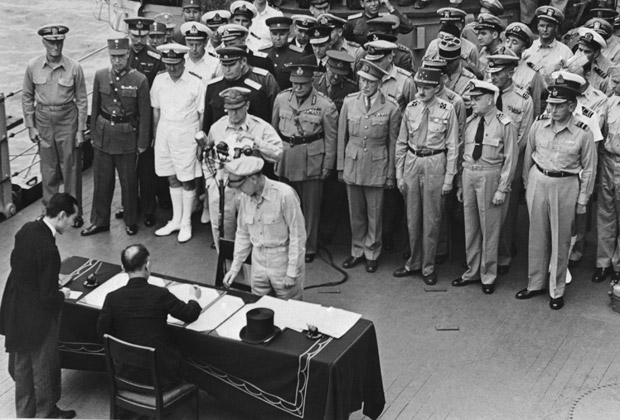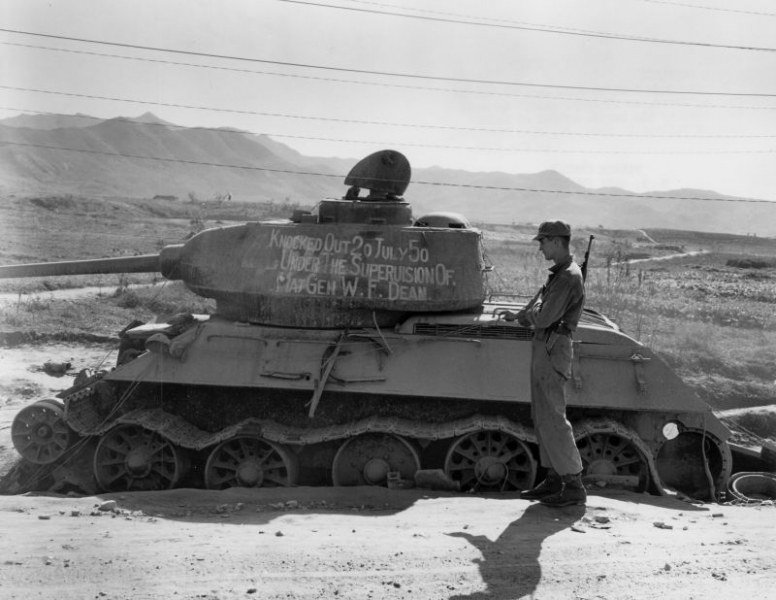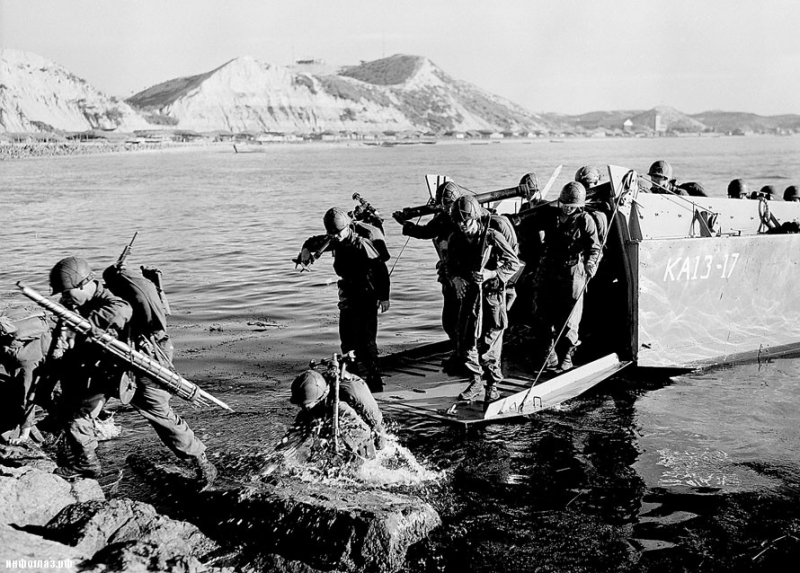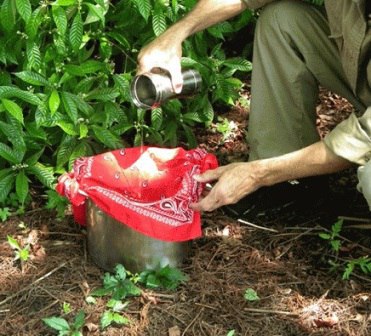
Japanese Foreign Minister Mamoru Shigemitsu signs the instrument of acceptance of the Potsdam Declaration
The outbreak 25 June 1950 year and lasted almost three years, the Korean War was fought between North Korea (North Korea) and South Korea (The Republic of Korea) for the purpose of unification of Korea forces of each party in a single state. In its preparation and in the course of North Korea relied on the help of the People's Republic of China and the Soviet Union. South Korea supported the US and several other countries - members of the UN.
Korea, Occupied Japan as a result of the Russian-Japanese War 1904-1905 years, It was in accordance with the decisions of the Cairo Conference, the Allied Powers (1 December 1934 of the year) to gain independence. This decision was confirmed by the Potsdam Declaration (26 July 1945 of the year). At the final stage of the Second World War, the leaders of the USSR and the United States came to an agreement, according to which the Soviet troops took the surrender of the Japanese forces, stationed on the Korean peninsula, in areas north, and the US - to the south of the dividing line, passing along the 38th parallel. Consequently, the sole purpose of the temporary partition of Korea into two zones was the adoption of the surrender of Japanese troops. However, almost immediately after the Second World War, the 38th parallel became a border between North and South Korea, between which from the outset was designated a difference in the approach to solving the problems of government. Joint Soviet-American Commission on Korea, created for the practical implementation of the decisions taken, and could not work out an acceptable formula of Education Korean state. As a result, the United States was able to take place in South Korea National Assembly elections and form the South Korean government headed by Syngman Rhee. 15 August 1948 It was proclaimed the formation of the Republic of Korea with its capital in Seoul. In turn, the North Korean authorities, declaring this illegal act, with the support of the Soviet military administration carried out their own choices and 9 September 1948 , proclaimed the formation of the Democratic People's Republic with its capital in Pyongyang.
By this time, both proclaimed republic already had its own armed forces, the creation of which took direct part the Soviet Union and the United States. So, ground troops, naval and air forces in South Korea were equipped with American weapons and equipment production. All leadership training, supply and use of the armed forces was run by a group of American advisers, numbering up to the beginning of the war 500 human. In turn, the Soviet Union to equip the Korean People's Army (KNA) provided weapons and equipment of Soviet manufacture. Institute of Soviet military advisers has been approved together with the establishment of the KPA. They are appointed from among the generals and officers of the 25th Army, Korea exempt from the Japanese in August 1945 of the year. In accordance with the USSR Council of Ministers Resolution of 16 May 1950 , the number of military advisers, instructors and maintenance personnel of the Soviet was determined to be 246 human. Soviet advisers were strictly forbidden to cross the 38th parallel, to avoid captivity.

105-I am North Korean Tank Brigade
War was preceded by numerous cross-border armed conflicts, provoked by both sides. The highest intensity they have acquired in the second half 1950 of the year. At the same time carried out the concentration of troops along the sides of the demarcation line - 38 parallels. AT 5 hours 25 June 1950 the troops of the Korean People's Army attacked the enemy on all fronts. Justifying the legality of their actions, North Korean Prime Minister Kim Il Sung 26 Jun said, that the troops of South Korea attacked the positions of the KPA and provoked its transition to the offensive. However, the field of UN observers, were in a war zone, refuted this statement and the responsibility for the outbreak of the Korean War, laid on the DPRK. The US government 25 June has put the Korean issue to the UN Security Council, which the 27 June received seven votes (I voted against Yugoslavia, Soviet delegation was absent) a resolution on the need to provide immediate military assistance to South Korea on the part of states - members of the UN. At the same time the Security Council has identified North Korea as an aggressor. It should be emphasized, that the Soviet side made a manifest error, absent during the discussion of this issue (The Soviet Union boycotted the UN in January 1950 of the year), and it has already put before the fact of joining the Army and US Navy forces in the war on the side of South Korea. In a statement from the Ministry of Foreign Affairs of the USSR 4 July 1950 year has been said about the "American armed intervention" in Korea, and the responsibility lies with the US government. However, this interpretation of events was suitable only for "internal use", as the Soviet society in this period was virtually isolated from the outside world and could not obtain objective information.
so, in the middle of the day 25 June, after a 30-minute artillery barrage troops northerners broke the enemy resistance in a number of areas and began to chase him off-side. Actions KPA troops were decisive character. Cleverly is¬polzuya forested mountainous terrain and the enemy's affection for roads, they sought to strike the flanks. The suddenness of the strike was one of the most important features of the fighting. However, due to heavy losses in manpower and materiel, absolute air supremacy US air offensive KPA was stopped, the enemy was able to gain a foothold in the Pusan bridgehead.

July 1950 of the year. American troops came to Pohang,on the east coast of Korea
Autumn 1950 the year began with the counter-offensive of the multinational UN force, for the Korean People's Army has fallen on hard times. After repeated requests from the North Korean government to IV. Stalin of the need to cover the rear of the Korean People's Army from the shock of US Air Force and the coordination of this issue with Mao Zedong, the Soviet government decided to set up on the territory of north-east China's largest Soviet air grouping. Major decisions on the composition of, deployment and development of the aviation group accepted the General Staff of the USSR Armed Forces, but their implementation was carried Command of the Air Force, the command of the Air Defense Forces and the 64th Fighter Aviation Corps.
The idea of the American komando¬vaniya was that, to sudden landing of amphibious assault at Inchon and the transition to the offensive of the 8th US Army from the Pusan bridgehead to encircle and destroy the main forces of the KPA. After fierce fighting, began 16 September, the enemy was able to break the defense of the KPA, by mid-October to move the fighting to the north of the 38th parallel, and in some na¬pravleniyah even go to the approaches to the Chinese border, that posed a threat to China. China has expressed a desire to help the Korean people in their struggle against the aggressors. 19 ok¬tyabrya began to advance into the territory of the DPRK People's Volunteers connections ki¬tayskih (KND) (30 infantry and 4 artille¬riyskie division). Together with the compounds they KPA 25 October 1950 year in the area Unzan, Hichen immediately hit amerikan¬skim and South Korean forces, and threw them into 45-50 km. Further, building on the success, KPA and CPV to 8 January 1951 year moved to 80-100 km south of the 38th parallel. but, uchi¬tyvaya terrain and lack of troops and weapons, from 20 February to 20 April troops of the KPA and CPV moved to the 38 th parallel and went on the defensive.
The Korean War ended 27 July 1953 years after the signing of the armistice agreement. Opposing forces remained on both sides of the 38th parallel, there, where he started three years ago fighting.
The overall result of the fighting Soviet forces of fighter aviation and antiaircraft artillery - 1309 shot down enemy planes. The Soviet side were captured, and then handed over to the Chinese and Korean troops 262 American pilot. As for the Soviet pilots, is one of the best was Captain Nikolai Sutyagin. He had 21 personal air victory. Among other Soviet pilots may also be isolated Col. E. Pepelyaeva, oderzhavsheho 20 aerial victories over the enemy, A lieutenant colonel. Smorchkova and Captain L. Shchukin (by 15 every downed aircraft), major D. Oskina and Captain M. Ponomareva (by 14 wins), capital. Kramarenko (13 wins), Senior Lieutenant D. Samoilova, brought down 10 aircraft.
For the successful implementation of government jobs by decree of the Presidium of the orders and medals of the Supreme Soviet of the USSR were awarded 3504 corps troops, a 22 pilot received the title of Hero of the Soviet Union.Gabriel Tsobehiya










